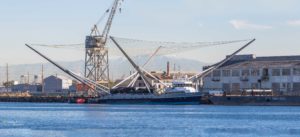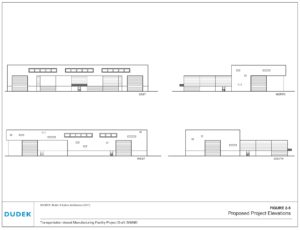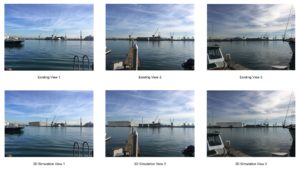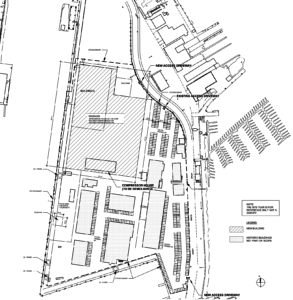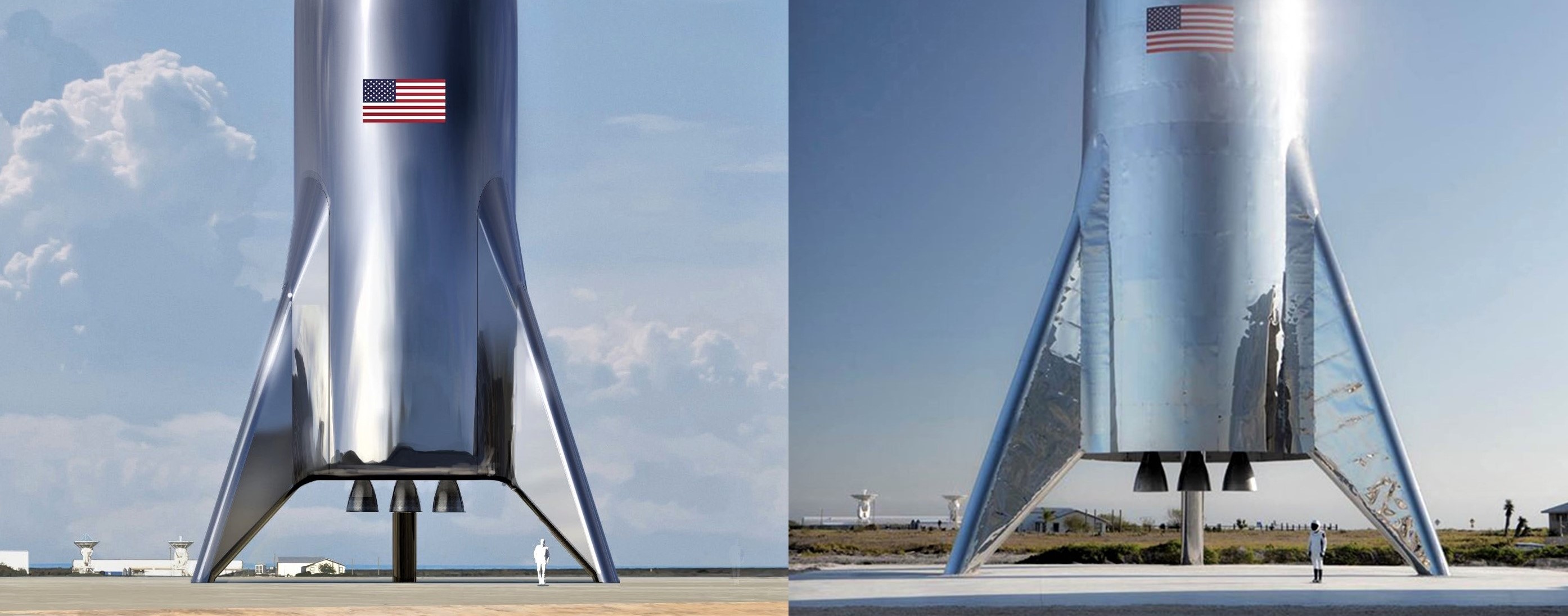

News
SpaceX to move Starship and Super Heavy production to Texas as hop tests near [updated]
SpaceX announced today that plans to ultimately build BFR (now known as Starship/Super Heavy) in the Port of Los Angeles have at least initially been replaced with a decision to move that development to South Texas, although details about the new facilities and their timelines remain have yet to be shared.
Drawn to one possible conclusion, this could mean that SpaceX no longer intends to build a BFR factory in the Port of Los Angeles, while all Falcon 9/Heavy, Merlin, and Raptor manufacturing will remain in the company’s Hawthorne, CA headquarters for the foreseeable future. However, the statements do not preclude the possibility that SpaceX still plans to develop an oceanside factory in the near future for Super Heavy, Starship, or both.
SpaceX will not longer be manufacturing its Mars spaceship and rocket booster at the Port of Los Angeles. Instead, the work will be done in South Texas. https://t.co/LqBfPawiZf
— Los Angeles Times (@latimes) January 16, 2019
Update: CEO Elon Musk stated on Twitter that the Los Angeles Times’ original report and a partial miscommunication on behalf of SpaceX misconstrued an official statement that early-stage Starship and Super Heavy prototype construction and development would stay in South Texas for the time being. It appears that SpaceX’s Port of LA plans remain largely unchanged.
The source info is incorrect. Starship & Raptor development is being done out of our HQ in Hawthorne, CA. We are building the Starship prototypes locally at our launch site in Texas, as their size makes them very difficult to transport.
— Elon Musk (@elonmusk) January 16, 2019
“To streamline operations, SpaceX is developing and will test the Starship test vehicle at our site in South Texas. This decision does not impact our current manufacture, design, and launch operations in Hawthorne and Vandenberg Air Force Base in California. Additionally, SpaceX will continue recovery operations of our reusable Falcon rockets and Dragon spacecraft at the Port of Los Angeles.” – SpaceX, January 16th, 2019
In early 2018, SpaceX announced that it had required a new berth in Port of San Pedro with the specific intention of building a brand-new BFR factory. By keeping BFR production in Los Angeles and locating it directly adjacent to its transportation mode of choice (a barge from California to Texas), the official hope was to retain the best aerospace talent in the US (generally centered around central California) and ensure that its main Hawthorne factory was just a short drive away while still being able to relatively affordably transport massive 9m/30 foot-diameter BFR spaceships and boosters between California and Texas.
Also speaking in 2018, COO and President Gwynne Shotwell noted that the estimated cost of moving a BFR-sized object from its main Hawthorne factory to Port of LA would average $5M for a one-way trip. For context, that is almost 10% of the list price of an entirely new Falcon 9 rocket ($62M) just to perform basic, necessary logistics. As a result, SpaceX decided to build a permanent factory at a Port of LA dock, where the company had already sprung a giant tent to begin prototype fabrication. Known as Berth 240, it’s now unclear whether SpaceX will retain and still develop the Port of San Pedro plot into a permanent facility, estimated to cost a few tens of millions of dollars to complete.
- SpaceX currently uses Berth 240 as fairing recovery vessel Mr. Steven’s base of operations. (Pauline Acalin)
- Most of the Berth 240 plot features decrepit but historic buildings from the early 20th century – SpaceX is required by its EIS to help preserve them and can only demolish one small hangar. (Pauline Acalin)
- Over the last six months, SpaceX has VERY gradually prepared the foundation of its prospective Berth 240 factory, although barely any visible progress has been made. (Pauline Acalin, 11/30/18)
- Blueprints of the proposed BFR factory at Berth 240. (SpaceX)
- Renders of the proposed BFR factory at Berth 240. (SpaceX)
- An overview of the two planned stages of BFR factory construction, March 2018. (SpaceX)
In the company’s approved environmental impact assessment, the implication was that the BFR factory could double as dedicated post-recovery processing and refurbishment facility for regular Falcon 9 missions and provide a far more spacious dock for drone ship Just Read The Instructions and support vessel NRC Quest. That sort of facility could easily still provide significant value to SpaceX, although it may be the case that it would not earn its keep nearly well enough to account for the redundancy of refurbishing at Port of LA instead of simply shipping recovered Falcon 9 boosters to the main Hawthorne factory, which can already host the refurbishment of at least two Falcon 9 boosters simultaneously.
Starship Hopper has been taken apart again (for the installation of the bulkhead etc.)
📸NSF's BocaChicaGalhttps://t.co/DlTj9Qiijz
NSF Overview News Article by Thomas Burghardt @TGMetsFan98 for those catching up:https://t.co/rgliFAkBMC pic.twitter.com/DzSJzjSvoI
— NSF – NASASpaceflight.com (@NASASpaceflight) January 15, 2019
SpaceX may also still want to have LA facilities capable of affordably supporting Starship and Super Heavy structures development and production in the event that some of its excellent staff of engineers and technicians are not interested in moving from Los Angeles to the sparsely-populated southeast tip of Texas. In the meantime, the company continues to work towards the completion of its first flightworthy(ish) Starship prototype at its rapidly expanding South Texas facilities, with CEO Elon Musk indicating that hop tests of the vehicle could begin as early as February or March 2019.
Expect a new article on the recent Starship hopper progress very soon!
Elon Musk
Tesla Supercharger Diner food menu gets a sneak peek as construction closes out
What are you ordering at the Tesla Diner?

The Tesla Supercharger Diner in Los Angeles is nearing completion as construction appears to be winding down significantly. However, the more minor details, such as what the company will serve at its 50s-style diner for food, are starting to be revealed.
Tesla’s Supercharger Diner is set to open soon, seven years after CEO Elon Musk first drafted the idea in a post on X in 2018. Musk has largely come through on most of what he envisioned for the project: the diner, the massive movie screens, and the intended vibe are all present, thanks to the aerial and ground footage shared on social media.
We already know the Diner will be open 24/7, based on decals placed on the front door of the restaurant that were shared earlier this week. We assume that Tesla Optimus will come into play for these long and uninterrupted hours.
The Tesla Diner is basically finished—here’s what it looks like
As far as the food, Tesla does have an email also printed on the front door of the Diner, but we did not receive any response back (yet) about what cuisine it will be offering. We figured it would be nothing fancy and it would be typical diner staples: burgers, fries, wings, milkshakes, etc.
According to pictures taken by @Tesla_lighting_, which were shared by Not a Tesla App, the food will be just that: quick and affordable meals that diners do well. It’s nothing crazy, just typical staples you’d find at any diner, just with a Tesla twist:
Tesla Diner food:
• Burgers
• Fries
• Chicken Wings
• Hot Dogs
• Hand-spun milkshakes
• And more https://t.co/kzFf20YZQq pic.twitter.com/aRv02TzouY— Sawyer Merritt (@SawyerMerritt) July 17, 2025
As the food menu is finalized, we will be sure to share any details Tesla provides, including a full list of what will be served and its prices.
Additionally, the entire property appears to be nearing its final construction stages, and it seems it may even be nearing completion. The movie screens are already up and showing videos of things like SpaceX launches.
There are many cars already using the Superchargers at the restaurant, and employees inside the facility look to be putting the finishing touches on the interior.
🚨 Boots on the ground at the Tesla Diner:
— TESLARATI (@Teslarati) July 17, 2025
It’s almost reminiscent of a Tesla version of a Buc-ee’s, a southern staple convenience store that offers much more than a traditional gas station. Of course, Tesla’s version is futuristic and more catered to the company’s image, but the idea is the same.
It’s a one-stop shop for anything you’d need to recharge as a Tesla owner. Los Angeles building permits have not yet revealed the date for the restaurant’s initial operation, but Tesla may have its eye on a target date that will likely be announced during next week’s Earnings Call.
News
Tesla’s longer Model Y did not scale back requests for this vehicle type from fans
Tesla fans are happy with the new Model Y, but they’re still vocal about the need for something else.

Tesla launched a slightly longer version of the Model Y all-electric crossover in China, and with it being extremely likely that the vehicle will make its way to other markets, including the United States, fans are still looking for something more.
The new Model Y L in China boasts a slightly larger wheelbase than its original version, giving slightly more interior room with a sixth seat, thanks to a third row.
Tesla exec hints at useful and potentially killer Model Y L feature
Tesla has said throughout the past year that it would focus on developing its affordable, compact models, which were set to begin production in the first half of the year. The company has not indicated whether it met that timeline or not, but many are hoping to see unveilings of those designs potentially during the Q3 earnings call.
However, the modifications to the Model Y, which have not yet been officially announced for any markets outside of China, still don’t seem to be what owners and fans are looking forward to. Instead, they are hoping for something larger.
A few months ago, I reported on the overall consensus within the Tesla community that the company needs a full-size SUV, minivan, or even a cargo van that would be ideal for camping or business use.
Tesla is missing one type of vehicle in its lineup and fans want it fast
That mentality still seems very present amongst fans and owners, who state that a full-size SUV with enough seating for a larger family, more capability in terms of cargo space for camping or business operation, and something to compete with gas cars like the Chevrolet Tahoe, Ford Expedition, or electric ones like the Volkswagen ID.BUZZ.
We asked the question on X, and Tesla fans were nearly unanimously in support of a larger SUV or minivan-type vehicle for the company’s lineup:
🚨 More and more people are *still* saying that, despite this new, longer Model Y, Tesla still needs a true three-row SUV
Do you agree? https://t.co/QmbRDcCE08 pic.twitter.com/p6m5zB4sDZ
— TESLARATI (@Teslarati) July 16, 2025
Here’s what some of the respondents said:
100% agree, we need a larger vehicle.
Our model Y is quickly getting too small for our family of 5 as the kids grow. A slightly longer Y with an extra seat is nice but it’s not enough if you’re looking to take it on road trips/vacations/ kids sports gear etc.
Unfortunately we…
— Anthony Hunter (@_LiarsDice_) July 17, 2025
Had to buy a Kia Carnival Hybrid because Tesla doesn’t have a true 3 row vehicle with proper space and respectable range. pic.twitter.com/pzwFyHU8Gi
— Neil, like the astronaut (@Neileeyo) July 17, 2025
Agreed! I’m not sure who created this but I liked it enough to save it. pic.twitter.com/Sof5nMehjS
— 🦉Wise Words of Wisdom – Inspirational Quotes (IQ) (@WiseWordsIQ) July 16, 2025
Tesla is certainly aware that many of its owners would like the company to develop something larger that competes with the large SUVs on the market.
However, it has not stated that anything like that is in the current plans for future vehicles, as it has made a concerted effort to develop Robotaxi alongside the affordable, compact models that it claims are in development.
It has already unveiled the Robovan, a people-mover that can seat up to 20 passengers in a lounge-like interior.
The Robovan will be completely driverless, so it’s unlikely we will see it before the release of a fully autonomous Full Self-Driving suite from Tesla.
Energy
Tesla launches first Virtual Power Plant in UK – get paid to use solar
Tesla has launched its first-ever Virtual Power Plant program in the United Kingdom.

Tesla has launched its first-ever Virtual Power Plant program in the United Kingdom. This feature enables users of solar panels and energy storage systems to sell their excess energy back to the grid.
Tesla is utilizing Octopus Energy, a British renewable energy company that operates in multiple markets, including the UK, France, Germany, Italy, Spain, Australia, Japan, New Zealand, and the United States, as the provider for the VPP launch in the region.
The company states that those who enroll in the program can earn up to £300 per month.
Tesla has operated several VPP programs worldwide, most notably in California, Texas, Connecticut, and the U.S. territory of Puerto Rico. This is not the first time Tesla has operated a VPP outside the United States, as there are programs in Australia, Japan, and New Zealand.
This is its first in the UK:
Our first VPP in the UK
You can get paid to share your energy – store excess energy in your Powerwall & sell it back to the grid
You’re making £££ and the community is powered by clean energy
Win-win pic.twitter.com/evhMtJpgy1
— Tesla UK (@tesla_uk) July 17, 2025
Tesla is not the only company that is working with Octopus Energy in the UK for the VPP, as it joins SolarEdge, GivEnergy, and Enphase as other companies that utilize the Octopus platform for their project operations.
It has been six years since Tesla launched its first VPP, as it started its first in Australia back in 2019. In 2024, Tesla paid out over $10 million to those participating in the program.
Participating in the VPP program that Tesla offers not only provides enrolled individuals with the opportunity to earn money, but it also contributes to grid stabilization by supporting local energy grids.
-

 Elon Musk1 day ago
Elon Musk1 day agoWaymo responds to Tesla’s Robotaxi expansion in Austin with bold statement
-

 News1 day ago
News1 day agoTesla exec hints at useful and potentially killer Model Y L feature
-

 Elon Musk2 days ago
Elon Musk2 days agoElon Musk reveals SpaceX’s target for Starship’s 10th launch
-

 Elon Musk3 days ago
Elon Musk3 days agoTesla ups Robotaxi fare price to another comical figure with service area expansion
-

 News1 day ago
News1 day agoTesla’s longer Model Y did not scale back requests for this vehicle type from fans
-

 News1 day ago
News1 day ago“Worthy of respect:” Six-seat Model Y L acknowledged by Tesla China’s biggest rivals
-

 News2 days ago
News2 days agoFirst glimpse of Tesla Model Y with six seats and extended wheelbase
-

 Elon Musk2 days ago
Elon Musk2 days agoElon Musk confirms Tesla is already rolling out a new feature for in-car Grok

